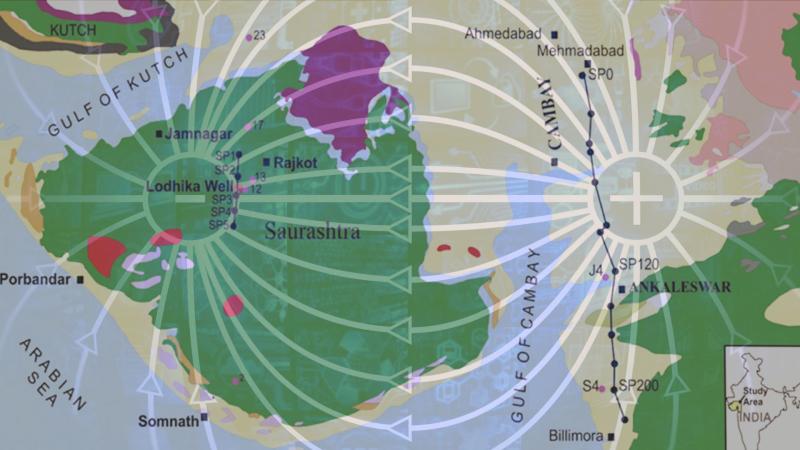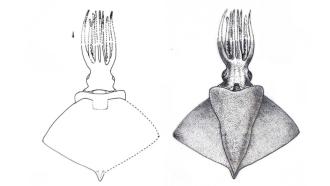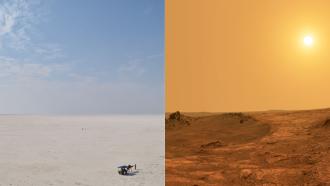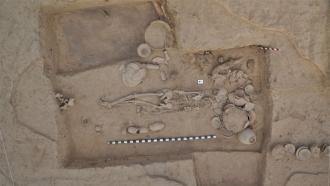
The Deccan Traps are one of the largest volcanic features globally, covering approximately 500,000 square kilometres of west-central India, including parts of Maharashtra, Madhya Pradesh, Gujarat, Karnataka, and Telangana. These massive flood basalts or volcanic sediments were formed from extensive volcanic eruptions that began around 66 million years ago. On the western coast, much of the volcanic flow settled in the Saurashtra and the Cambay basins. Earlier studies have indicated potentially rich sedimentary deposits in these basins that could hold significant amounts of natural gas, as well as clues about the Earth's deep history.
Finding and mapping theseayers is crucial for any kind of exploration. The volcanic cover, however, acts like a thick, impenetrable shield and is incredibly difficult to see through. Traditional methods, such as seismic surveys, which rely on bouncing sound waves off underground layers, are not very effective because dense layers don't reflect sound waves well. Researchers have been developing new ways to overcome this challenge.
Did You Know? The Deccan Traps are one of the largest volcanic provinces on Earth, covering an area bigger than France! They erupted around 66 million years ago, at roughly the same time as the extinction of the dinosaurs. |
New research from the Indian Institute of Technology ( IIT-ISM) Dhanbad and IIT Bombay has explored a technique called Magnetotellurics (MT) to address the lack of visibility. Unlike seismic methods, MT uses Earth's natural electromagnetic signals – tiny electrical currents and magnetic fields in the ground – to map underground structures. Different types of rocks and layers conduct electricity differently, a property known as the resistivity of the material. MT measures how these natural signals change at various frequencies to build a picture of the layers below, based on their electrical properties. Similar to using a metal detector, but on a much larger scale and sensitive to electrical conductivity rather than just metal. MT is particularly well-suited for seeing deep into the Earth, making it ideal for examining the layers beneath the thick Deccan Traps.
However, interpreting MT data isn't always straightforward, with many possible solutions. To solve for this, the researchers employed an inversion process. Using mathematical methods, they found the most likely underground structure, like the layers, their thicknesses, and their resistivities, that would produce the MT signals measured at the surface. However, inversion methods can sometimes struggle to find the best solution and can be uncertain, especially in complex areas like those covered by volcanic rock.
The scientists developed and tested a new strategy that combines MT data with a computer algorithm called the Improved Wolf Optimisation Algorithm (IWOA). This algorithm uses a smart search, exploring many possible underground models to find the one that best fits the MT data. They compared IWOA against other nature-inspired algorithms like the standard Whale Optimisation Algorithm (WOA), Particle Swarm Optimisation (PSO), and Gravitational Search Algorithm (GSA) using theoretical data representing known underground structures. IWOA proved to be faster and more accurate in finding the correct model parameters with less error.
To further classify all the models that fit the parameters, the researchers used Bayesian statistics, specifically the Bayesian posterior probability density function (PDF). After the IWOA algorithm generates many possible underground models that fit the data reasonably well, the Bayesian PDF helps to identify the most probable models and quantify the uncertainty associated with the results. By focusing on models within a certain confidence interval (like the 68.27% confidence interval mentioned in the paper), they can calculate an average model that is more reliable and less uncertain than any single model found by the optimisation alone.
Applying this combined IWOA and Bayesian approach to real MT data from the Saurashtra and Cambay basins yielded impressive results. In the Cambay basin, their method successfully identified layers corresponding to alluvium (surface sediment), Tertiary sediments, the Deccan Trap, Mesozoic sediments, and the underlying basement rock. The depths and resistivities of these layers matched well with information from nearby drill holes and previous seismic surveys, especially for the Tertiary and Deccan Trap layers. For example, at one site (S4), the inverted model showed Tertiary sediments from about 230m to 1533m depth, aligning closely with seismic data.
In the Saurashtra region, applying the method across a profile of MT sites revealed a detailed 2D cross-section of the subsurface. It clearly showed a thin layer of alluvium at the top, followed by the thick Deccan Trap basalt, then a significant layer of lower-resistivity Mesozoic sediments (which are potential hydrocarbon reservoirs), and finally the high-resistivity basement rock. The thickness of the Mesozoic layer varied across the profile, pinching out towards one side and being thickest (around 1850m) in another area (near site S17), consistent with geological expectations. The depths to the bottom of the Deccan Trap and the Mesozoic sediments also aligned well with data from a deep borehole in the area.
This new strategy significantly improves upon previous methods like the Marquardt algorithm, which the paper also compared against. While Marquardt could provide reasonable models, the IWOA + Bayesian approach consistently produced more stable models. It had less uncertainty in the layer parameters and provided better resolution of the different geological units, particularly the crucial Mesozoic sedimentary layer hidden beneath the traps. The Bayesian analysis helped to filter out less probable models and quantify the reliability of the final result. The paper notes that some minor discrepancies between observed and calculated data, especially at specific frequencies, may be due to noise or the presence of more complex 3D geological structures that a 1D model can't fully capture. However, overall, the method performed very well.
The ability to reliably image subsurface structures, especially beneath challenging volcanic cover, has direct benefits for society. By accurately mapping the depth and extent of potential hydrocarbon-bearing sedimentary layers, this research can help energy companies explore more efficiently and successfully, potentially leading to new discoveries. Beyond energy, this method can also be valuable for mapping groundwater resources, mineral deposits, or understanding the geological structure of an area for hazard assessment. The IWOA + Bayesian strategy offers a more precise and confident way to peek beneath the surface and unlock the secrets held within Earth's crust, contributing to both resource exploration and our fundamental understanding of geology.
This article was written with the help of generative AI and edited by an editor at Research Matters.






